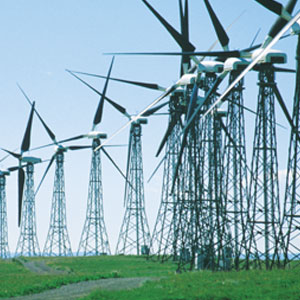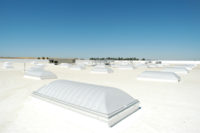Buildings continue to be the largest consumers of energy, by sector, in the U.S. The USGBC is constantly looking for new and innovative ways to address this. Through the LEED Pilot Credit Library, often referred to as “LEED’s test kitchen,” project teams can test-run innovative, energy-saving, proposed LEED credits that have the potential to make a big impact.
First, some background: The LEED Pilot Credit Library is a collection of LEED credits that are available for testing but have not yet become part of the LEED rating system. Project teams can earn LEED points by completing these credits and then sharing their findings. The information that these project teams share is crucial to the refinement of the proposed credits and their adoption into the LEED rating system. Each innovative and cutting-edge addition drives the industry to higher levels of sustainability. Plus, project teams can earn up to five LEED credits by trying out the pilot credits—so utilizing pilot credits benefits the industry and the development of the rating system as well as LEED projects and the teams behind them.
LEED pilot credits range from designing bird-friendly façades to optimizing building acoustics, but the credits we’re focused on in this piece are those that hold big promise for energy efficiency.
Energy Jumpstart: The 69 Percent
Through the Energy and Atmosphere pilot prerequisite 2 (EAp2)—known as Pilot Credit 67 or “Energy Jumpstart”—LEED is opening the door to existing buildings projects that currently cannot meet the minimum energy requirements for the LEED rating system. These buildings, existing buildings that have the greatest potential for energy savings, represent a significant opportunity to reduce the overall environmental, social and economic impacts of the energy used by the built environment. A small investment in efficiency in these buildings can yield substantially more savings than large investments in already high-performing buildings. Energy Jumpstart seeks to address this problem by opening up a certification pathway that encourages buildings with this potential to satisfy the energy prerequisites by significantly improving their energy performance and committing to continuous improvement over time, thus creating an access point for projects that were likely not considering seeking LEED certification but represent huge potential savings.
Here’s how it works: The minimum energy prerequisite acts as a gatekeeper for existing buildings projects pursuing LEED for Existing Buildings: Operations and Maintenance (LEED-EB: O&M) certification by requiring projects to achieve an ENERGY STAR score of at least 69 (these buildings must demonstrate energy performance in the top 30 percent among peer buildings).
But what about projects that aren’t currently meeting this requirement and won’t without substantial effort? These buildings have huge potential for significant energy reductions and similarly benefit from the other requirements of the LEED-EB: O&M rating system (water efficiency, indoor air quality, waste minimization) but do not pursue LEED because they cannot achieve an ENERGY STAR score of 69.
Enter Energy Jumpstart: Through this pilot credit, projects that demonstrate a 20 percent increase in energy efficiency over a 12-month period (compared to a three-year baseline) satisfy EAp2 and can achieve LEED certification at the Certified level if they have satisfied the remaining prerequisites and earned enough points. The pilot credit measures the project’s individual progress as opposed to its standing amongst peers. The previous barrier to entry is gone and has been replaced by a strong motivation to get moving.
This is just the start of the journey for these projects. Energy Jumpstart projects are encouraged to continue to make improvements in energy efficiency over time. And since all projects certified under LEED-EB: O&M must recertify every five years to ensure ongoing performance, they have the opportunity to reach the Silver, Gold or even Platinum level through the recertification process. A project that utilized Energy Jumpstart to get started with LEED could, with enough elbow grease and demonstrated performance, ultimately recertify as Platinum. Who doesn’t love a great underdog story?
Energy Jumpstart is good for the entire industry because it swings the door open a little wider, providing an incentive for the 69 percent of the market that is currently excluded from LEED to improve their energy efficiency. The pilot credit also quite literally jumpstarts energy savings and good energy-efficiency practices in these projects. Saving energy—even in smaller amounts —is a plus for the environment and the economy. And through the LEED Recertification program, these projects are primed to achieve even bigger savings down the road.
Energy Jumpstart represents an exciting opportunity for sectors of the existing buildings market to get started with LEED—but if you don’t use it, we’ll lose it. Like all pilot credits, Energy Jumpstart will remain in the library for testing and market feedback before it can be incorporated into the LEED rating system. If it’s not used by enough projects to test it successfully, it may have to be removed from the library.
Demand Response: Both Sides of the Grid
Another pilot credit with big energy-savings and economic potential is Demand Response, Energy and Atmosphere Pilot Credit 8. Demand response in a nutshell: When the grid becomes stressed with too much demand, user-side electricity consumption can be scaled back. This creates opportunities for buildings to respond to grid stress in a way that benefits both electricity providers and the buildings themselves: Those who reduce energy use at times of high demand on the grid may be eligible for direct compensation, tax incentives, rebates on future energy purchases and other benefits.
A popular demand response analogy is based on airline booking. When airlines overbook a flight, they ask for volunteers who are willing to trade their seats in return for a flight voucher or some other perk. Think of the utility companies as the airlines, and buildings as the consumers who, in return for financial compensation, can scale back energy usage during peak usage times. The Demand Response credit requirements encourage building owners to take advantage of the utility incentives available for buildings that help them reduce stress and improve the reliability of the grid. Like Energy Jumpstart, this is another win-win for both sides of the grid.
Pilot Credit 8, Demand Response, was posted July 2010, marking the first time that LEED projects were able to achieve points for participating in demand response programs. Demand Response will shed its pilot credit status with the release of the next update to the rating systems, LEED v4. Demand Response will “graduate” and become a credit within the LEED rating system.
For more information about Energy Jumpstart, please visit: http://bit.ly/11slF7n
For more information about Demand Response, please visit: http://bit.ly/WCQ4ds






